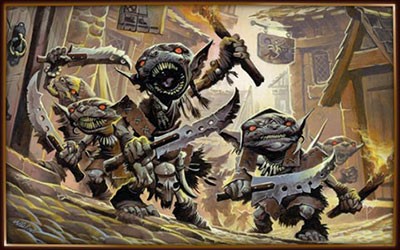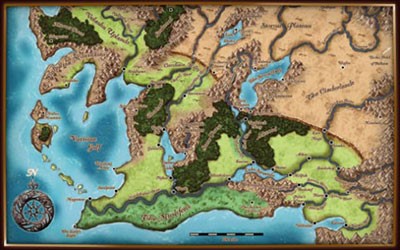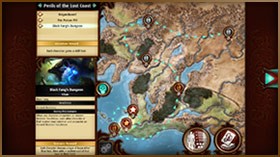Pathfinder Adventures: Paizo & Obsidian’s Nerd-Gasmic Union
When I first heard that Paizo, the publisher of the massively successful Pathfinder games, was teaming up with Obsidian Entertainment, the legendary video game studio, I knew good things were to come. The result of this Nerd-gasmic union is the phenomenally good Pathfinder Adventures. A faithful-to-a-fault adaptation of the break through gaming juggernaut that is the Pathfinder Adventure Card Game.
For the uninitiated amongst you, Pathfinder is the Tabletop Role Playing Game phoenix that rose from the ashes of the D&D dice from the 3rd edition of Dungeons and Dragons. As if its creators were some otherworldly travelers from a parallel universe where Dungeons and Dragons 4th Edition had never happened, Pathfinder is truly the spiritual successor of 3.5 D&D. This is hardly a surprise when you consider that previously the talents of Paizo were spent publishing Dungeon and Dragon magazine. Fast forward several years of Pathfinder glory to 2013, when the Pathfinder Adventure Card Game (PACG) debuts at Gen Con.
PACG is a stripped down dungeon crawl that manages to capture the TRPG combat and exploration experience without the bother of tedious number crunching, rules lawyering combat, or pouring over rule books. It found its niche in the space between your more traditional CCGs (think Magic: the Gathering or Pokemon) and its source material, traditional tabletop RPGs. The model they adopted (and in my opinion are the only ones to successfully implement) is that of the so called ‘LCG’ or Living Card Game. Popularized by, and maybe even coined by, the game manufacturing giant Fantasy Flight, The Living Card Game is a game, with cards, that evolves over time.
Complex Ideas, Right?
The base game, in theory, provides the players with enough material to see them through enough game play to justify the games cost, while subsequent expansions or supplements expand the card selection and/ or rules. The difference between this game and the more popular CCGs are how the cards are packaged. You don’t get random cards in packs, you buy all the cards in an expansion in one go, and play with them all in the same way. A concept that never really caught on for other incarnations of this market (Lord of the Rings LCG or Game of Thrones LCG both published by Fantasy Flight).
Pathfinder seems to be the exception to this gaming footnote and even though Paizo themselves do not brand their offering as a Living Card Game, it is clearly the model they have adopted. Now on their third ‘season’, Wrath of the Righteous, the Adventure Card Game shows no sign of waning popularity.
Basically it plays out like this. Deal out some location cards, these represent the areas you will be exploring. Deal out a random assortment of monsters, traps, loots, and other helpful adventurers that represent what you will encounter at that location. Assemble your deck of weapons, armor, spells, items, and allies which will represent your characters abilities (and also serve as your health pool, more on that in a bit). Take turns flipping cards off the location decks and seeing what your character
encounters: a monster to defeat, some sweet loot to collect, or maybe just a rusty old dagger someone dropped on the ground. Each card contains all the rules you need to understand how to defeat or acquire the card. It really is as simple as that, but that simplicity masks a thoughtful and intricate design. The more of your abilities you utilize (cards you play), the more exertion it places upon your character (cards you have to draw) and the closer it brings you to death (running out of cards in your deck). Combat damage dealt to you translates into cards you must discard, further depleting your pool. This dynamic creates a subtle balance between over playing your cards to generate too much over kill versus underplaying them, which results in taking damage and losing those cards anyways.
Enter Obsidian and their Stunning Adaptation
They have managed to capture the feel and enjoyment of the original while finding a distinctiveness of their own. Even if you are already familiar with the paper version, the pace and style of this implementation will bring you back for more. You will not be lacking in enjoyment just for being familiar with the game. The art is taken directly from the source material, but the backgrounds and visual effects add a layer of immersion that gives the game an anchor to the fantasy world of Pathfinder that is missing from the physical version. They have even added some thin dialog between the player characters and the more iconic allies depicted in the game to create a coherent and well-constructed story. Together this compensates for the lack of character development and depth the paper game purposefully eschews.
While the game itself is free to download, Obsidian has presented us with an installation based publishing scheme. New content is delivered semi-regularly much like the paper version. While I generally tend to shy away from “Freemium” games, this one is much fairer than others of the genre: both in pricing and offerings. Out of the box you get about 60% of the base game and 2 characters (the rogue and the cleric), for free. In order to unlock additional characters or adventures, you have to buy them with in game currency. I know, right, not this old hat again. Sounds a bit routine for a handheld game, I grant you. What makes this different for me is how they have implemented it. They only have 1 currency: Gold. The only mechanics for generating gold are either buying it with real money or completing adventures: either via the ‘story mode’, which is a pound for pound recreation of the paper scenarios, or the ‘Quest mode’ which is basically just a randomized scenario generated from the existing locations, monsters, and scenario rules. Defeating monsters and exploring locations grants you a tiny amount as well, but the main driver is completing adventures.
On top of that is the pricing. $25 nets you all the content for the first installation (‘Rise of the Runelords’) which consists of all the characters and all 6 adventures as they are published. That sounds like a fair chunk of change for an app until you consider that nearly all of the content and the paper equivalent would run you upwards of $180. There is, of course, a mechanic called ‘chests’ you can purchase that will allow you to add additional (and often times better) cards to your games vault (the pool of all the cards you will encounter throughout the game). Think buying packs in Hearthstone. This is their way of generating some recurring currency dump and presumably the main driver for their gold sales. So far, I have never found myself wanting because of a lack of these additional cards, and as far as I can tell they are pretty superfluous. Although to be fair, the chests do offer up a lot of pretty cool magic weapons and items that the inner geek in me wants my characters to wield and my inner completionist demands I acquire.
Let’s Talk Currency
The game launched back on April 28th and after playing off and on for about a month (with more than the usual amount of bugs and glitches I’m used to seeing from Obsidian), I’ve already unlocked all the content they currently have available for grand total real world cost of $2. And even that I only spent as a small ‘Thank you’ for delivering such a fun game. I totally did not need to. I had most of the content unlocked in the first week, just from playing the game. In my opinion it’s fairly easy to generate in game currency, and the pricing structure they have is pretty low. Each completed adventure nets you about 200-250 gold, each scenario pack of 5 adventures (containing additional loot /monsters/ traps /etc) costs 4000 gold. Those of us prone to the maths can tell you that’s only 16-20 completed adventures. That’s not a terribly large amount of playing. Additional characters will run you 1500 gold each. By the time I was finished with the adventures provided in the base game, I had enough gold for a new character (FYI: I chose the sorceress). A subsequent play through with her netted me enough money for the first scenario pack since it’s on sale right now. By the time I finished that one, I had another character and was most of the way to earning the second scenario pack. The third pack drops at the end of this week, and I anticipate I’ll have enough for that too.
Ok, So it’s a Good Port of a Fun Game, So What?

That’s the Good, What About the Bad and the Ugly?
Ok, as I eluded to before: this game’s got bugs. When it launched it had a lot of bugs. Some of them game breaking on some devices. I personally have lost a game save or two. That being said, Obsidian has already pushed out a patch that has addressed the most egregious offenders. The game is now infinitely more stable. Many, if not all, of the game breakers have been dealt with. The pending patch is also promising even more fixes. To their credit they are very responsive on the forums to all of the bugs and issues being reported there, which you would expect from a studio like Obsidian. Still the overall impression is the game was half baked. At launch there was no quest mode, no multiplayer, and you can’t switch devices. The latter being a real pain for those that have already switched devices due to a contract renewal. All of which they have promised to fix. Perhaps the hardest pill to swallow is, for now, it’s tablet only. While the Android tote-ers among us can download this on their phones because of Google Play, we Apple loving iPhone owners have to go without. Obsidian has frequently stated that phones and a Steam version will be supported in the near future. I can’t see that being the main focus right now with so many bugs and missing features in the current iteration.
Bottom Line, Play It.
The game is free, it has a really good ratio on return of time investment to in game currency, it’s stupid fun even with all its flaws and it’s only going to get better as they smooth those out. If you’re into table top role players this is right up your alley. If you play hand held games, you definitely want to grab this one. If you are into having fun, this game is for you.






